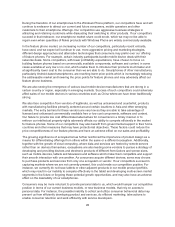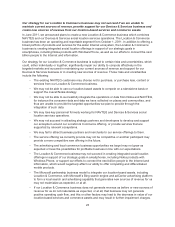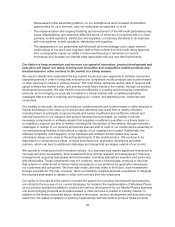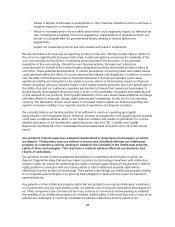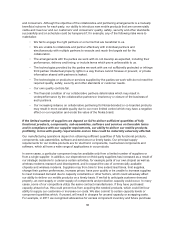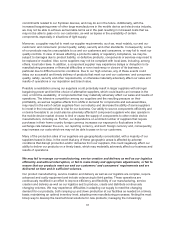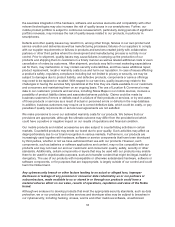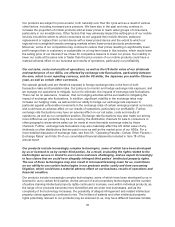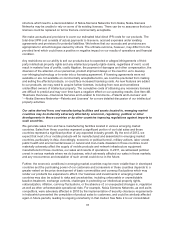Nokia 2011 Annual Report Download - page 31
Download and view the complete annual report
Please find page 31 of the 2011 Nokia annual report below. You can navigate through the pages in the report by either clicking on the pages listed below, or by using the keyword search tool below to find specific information within the annual report.enforceable, which could harm our competitive position. Also, if any of our key patents are invalidated,
or if the scope of the claims in any of these patents is limited by a court decision, we could be
prevented from using such patents as a basis for product differentiation or from licensing the
invalidated or limited portion of our intellectual property rights, or we could lose part of the leverage we
have in terms of our own intellectual property rights portfolio. Even if such a patent challenge is not
successful, it could be expensive and time-consuming, divert attention of our management and
technical personnel from our business and harm our reputation. Any diminution of the protection that
our own intellectual property rights enjoy could cause us to lose some of the benefits of our
investments in research and development, which may have a negative effect on our business and
results of operations. See Item 4B. “Business Overview—Devices & Services and Location &
Commerce—Patents and Licenses” and “—Nokia Siemens Networks—Patents and Licenses” for a
more detailed discussion of our intellectual property activities.
Our ability to maintain and leverage our traditional strengths in the mobile product market may
be impaired if we are unable to retain the loyalty of our mobile operator and distributor
customers and consumers as a result of the implementation of our strategies or other factors.
We have a number of competitive strengths that have historically contributed significantly to our sales
and profitability. These include our scale, our differentiating brand, our world-class manufacturing and
logistics system, the industry’s largest distribution network and our strong relationships with our mobile
operator and distributor customers. Going forward, these strengths are critical core competencies that
we bring to the partnership with Microsoft and the implementation of our Windows Phone smartphone
strategy. Our ability to maintain and leverage these strengths also continues to be important to our
competitiveness in the feature phone market.
As discussed above, however, the Microsoft partnership and the adoption of Windows Phone as our
primary smartphone platform are subject to certain risks and uncertainties. Several of those risks and
uncertainties relate to whether our mobile operator and distributor customers and consumers will be
satisfied with our current strategy and partnership with Microsoft going forward. If those risks
materialize and mobile operator and distributor customers and consumers as a consequence reduce
their support and purchases of our mobile products, this would reduce our market share and net sales
and in turn may erode our scale, brand, manufacturing and logistics, distribution and customer
relations. The erosion of those strengths would impair our competitiveness in the mobile products
market and our ability to execute successfully our new strategy and to realize fully the expected
benefits of the Microsoft partnership.
Also, as result of market developments, competitors’ actions or other factors within or out of our
control, we may not be able to maintain these competitive strengths that we have benefited from
historically. It is also possible that such strengths or some of them become less relevant in the future or
are replaced by other type of strengths required for future success in the mobile product market.
If any of the companies we partner and collaborate with, including Microsoft and Accenture,
were to fail to perform as planned or if we fail to achieve the collaboration or partnering
arrangements needed to succeed, we may not be able to bring our mobile products or location-
based or other services to market successfully or in a timely way.
We are increasingly collaborating and partnering with third parties to develop technologies and
products for our smartphones and feature phones. These arrangements involve the commitment by
each party of various resources, including technology, research and development efforts, services and
personnel. Today, mobile products are developed in an ecosystem of multiple partnerships with
different industry participants where our ability to collaborate successfully with the right partners is
critical to our success in creating and delivering mobile products that are preferred by our customers
29



